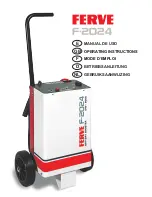
4
Wh or less are “excepted” from certain Class 9 DG
requirements. Always check compliance of Li-Ion
battery consignments against the current regulations
governing the chosen mode of transport. When in
doubt, contact the carrier or other trained Dangerous
Goods professional to confirm acceptability. Li-Ion
packs are shipped under classification UN 3480
(battery only) or UN 3481 (batteries contained in or
packed with equipment).
WARNING
To reduce the risk of injury or ex-
plosion, never burn or incinerate a
battery pack even if it is damaged, dead or com
-
pletely discharged. When burned, toxic fumes
and materials are created.
Disposing of MILWAUKEE Li-Ion
Battery Packs
MILWAUKEE Li-Ion battery packs are more environ
-
mentally friendly than some other types of power tool
battery packs (e.g., nickel-cadmium). Always dispose
of your battery pack according to federal, state and
local regulations. Contact a recycling agency in your
area for recycling locations.
Even discharged battery packs contain some energy.
Before disposing, use electrical tape to cover the
terminals to prevent the battery pack from shorting,
which could cause a fire or explosion.
RBRC Battery Recycling Seals
The RBRC™ Battery Recycling Seals (see "Sym
-
bology") on your tool battery packs indicate that
MILWAUKEE has arranged for the recycling of
that battery pack with the Rechargeable Battery
Recycling Corporation (RBRC). At the end of your
battery pack's useful life, return the battery pack to
a MILWAUKEE Branch Office/Service Center or the
participating retailer nearest you. For more informa-
tion, visit the RBRC web site at www.rbrc.org.
CHARGER
OPERATION
WARNING
Charge only MILWAUKEE Li-Ion
battery packs in the MILWAUKEE
Li-Ion Battery Charger. Other types of batteries
may cause personal injury and damage. Battery
pack and charger are not compatible with V™-
technology or NiCd systems.
To reduce the risk of electric shock, do not allow
water to flow into AC/DC plug.
AC/DC Charger (Cat. No. 2710-20)
To reduce the risk of damage to the charger, do not
attempt to plug into both AC and DC outlets at the
same time.
A
B
To use the AC/DC plug in a DC outlet, rotate the DC
adapter out (A) and insert into a DC outlet. The AC
plug blades should be folded in.
To use the AC/DC plug in an AC outlet, rotate the AC
plug blades out (B) and insert into an AC outlet. The
DC adapter should be folded in.
NOTE:
Immediately after using the battery pack,
the Fuel Gauge may display a lower charge than it
will if checked a few minutes later. The battery cells
"recover" some of their charge after resting.
Battery Pack Protection
To protect itself from damage and extend its life, the
battery pack’s intelligent circuit monitors current draw
and temperature. In extremely high torque, binding,
stalling, and short circuit situations, the battery pack
will turn OFF the tool if the current draw becomes
too high. All the fuel gauge lights will flash. Release
the trigger and restart.
Under extreme circumstances, the internal tem
-
perature of the battery could become too high. If
this happens, the fuel gauge lights will flash in an
alternating pattern and the tool will not run. Allow the
battery to cool down.
Fuel Gauge Lights Diagnosis
Solution
Lights 1 - 4 Solid
Remaining run time Continue working
1 Light, flashing
slowly
Less than 10% run
time left
Prepare to charge pack
1 Light, flashing
quickly
End of discharge
Charge pack
Lights 1-4, flashing
quickly
Current draw too
high
Release trigger and
restart, reduce pressure
Lights 1&3 / 2&4,
flashing alternatingly
Battery temperature
too high
Release trigger and allow
battery to cool
Cold Weather Operation
MILWAUKEE Li-Ion battery packs are designed to
operate in temperatures below freezing. When the
battery pack is too cold, it may need to warm up
before normal use. Put the battery on a tool and use
the tool in a light application. It may “buzz” for a short
time until it warms up. When the buzzing stops, use
the tool normally.
WARNING
To reduce the risk of fire, personal
injury, and product damage due to
a short circuit, never immerse your tool, battery
pack or charger in fluid or allow a fluid to flow
inside them. Corrosive or conductive fluids, such
as seawater, certain industrial chemicals, and
bleach or bleach containing products, etc., can
cause a short circuit.
Maintenance and Storage
Do not expose your battery pack or cordless tools
to water or rain, or allow them to get wet. This could
damage the tool and battery pack. Do not use oil or
solvents to clean or lubricate your battery pack. The
plastic casing will become brittle and crack, causing
a risk of injury.
Store battery packs at room temperature away from
moisture. Do not store in damp locations where cor-
rosion of terminals may occur. As with other battery
pack types, permanent capacity loss can result if
the pack is stored for long periods of time at high
temperatures (over 120° F). MILWAUKEE Li-Ion
battery packs maintain their charge during storage
longer than other battery pack types. After about a
year of storage, charge the pack as normal.
Transport
Personal transport of Li-Ion battery packs is allowed
when done in accordance with these warnings and
instructions. The proper classification, packaging, la
-
beling, marking, and documentation requirements for
shipping Li-Ion batteries is dependent upon whether
the particular batteries are rated greater than or less
than 100 Wh. Generally, Li-Ion batteries rated 100
























